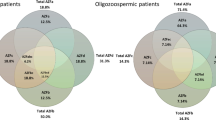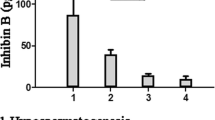Abstract
Purposes
To detect the frequency and types of chromosomal anomalies with non-obstructive azoospermia and severe oligozoospermia in Northeast China, and to compare the frequencies with other regions of China and the world. To investigate the general characteristics of this population.
Methods
Eighty-one men with non-obstructive azoospermia and 54 men with severe oligozoospermia were recruited. Karyotype analyses were performed on peripheral blood lymphocytes using standard G-banding. Measurements of follicle-stimulating hormone, testosterone, prolactin, and inhibin B were obtained.
Results
The frequency of chromosomal anomalies for patients with non-obstructive azoospermia (17.28%) was comparable with studies from Europe, Africa, Asia, and other regions of China. However, the frequency for patients with severe oligozoospermia (9.26%) was slightly higher than reported from other Asian countries. The infertile men were more likely than the fertile to smoke and consume alcohol, and to have significantly lower levels of inhibin B.
Conclusions
For infertile men in Northeast China, chromosome analysis is a necessary part of routine genetic testing, and the contributing effects of high smoking and alcohol consumption rates of this population should be discussed during genetic counseling.
Similar content being viewed by others
References
Balkan M, Tekes S, Gedik A. Cytogenetic and Y chromosome microdeletion screening studies in infertile males with oligozoospermia and azoospermia in Southeast Turkey. J Assist Reprod Genet. 2008;25:559–65.
Kleiman SE, Yogev L, Gamzu R, Hauser R, Botchan A, Lessing JB, Paz G, Yavetz H. Genetic evaluation of infertile men. Hum Reprod. 1999;14(1):33–8.
Ceylan GG, Ceylan C, Elyas H. Genetic anomalies in patients with severe oligozoospermia and azoospermia in eastern Turkey: a prospective study. Genet Mol Res. 2009;8(3):915–22.
Kosar PA, Ozcelik N, Kosar A. Cytogenetic abnormalities detected in patients with non-obstructive azoospermia and severe oligozoospermia. J Assist Reprod Genet. 2010;27:17–21.
Dohle GR, Halley DJ, Van Hemel JO, van den Ouwel AM, Pieters MH, Weber RF, Govaerts LC. Genetic risk factors in infertile men with severe oligozoospermia and azoospermia. Hum Reprod. 2002;17(1):13–6.
Martin RH. Cytogenetic determinants of male fertility. Hum Reprod Updat. 2008;14(4):379–90.
Foresta C, Garolla A, Bartoloni L, Bettella A, Ferlin A. Genetic abnormalities among severely oligospermic men who are candidates for intracytoplasmic sperm injection. J Clin Endocrinol Metab. 2005;90(1):152–6.
Elghezal H, Hidar S, Braham R, Denguezli W, Ajina M, Saâd A. Chromosome abnormalities in 1,000 infertile males with nonobstructive sperm disorders. Fertil Steril. 2006;86(6):1792–5.
Mohammed F, Al-Yatama F, Al-Bader M, Tayel SM, Gouda S, Naguib KK. Primary male infertility in Kuwait: a cytogenetic and molecular study of 289 infertile Kuwaiti patients. Andrologia. 2007;39(3):87–92.
Vutyavanich T, Piromlertamorn W, Sirirungsi W, Sirisukkasem S. Frequency of Y chromosome microdeletions and chromosomal abnormalities in infertile Thai men with oligozoospermia and azoospermia. Asian J Androl. 2007;9(1):68–75.
Nagvenkar P, Desai K, Hinduja I, Zaveri K. Chromosomal studies in infertile men with oligozoospermia & non-obstructive azoospermia. Indian J Med Res. 2005;122(1):34–42.
Ng PP, Tang MH, Lau ET, Ng LK, Ng EH, Tam PC, Yeung WS, Ho PC. Chromosomal anomalies and Y-microdeletions among Chinese subfertile men in Hong Kong. Hong Kong Med J. 2009;15(1):31–8.
Chiang HS, Wei HJ, Chen YT. Genetic screening for patients with azoospermia and severe oligo-asthenospermia. Int J Androl. 2000;23(2):20–5.
Zhou-Cun A, Yang Y, Zhang SZ, Zhang W, Lin L. Chromosomal abnormality and Y chromosome microdeletion in Chinese patients with azoospermia or severe oligozoospermia. Yi Chuan Xue Bao. 2006;33(2):111–6.
World Health Organization. WHO laboratory manual for the examination of human semen and sperm-cervical mucus interaction. 4th ed. Cambridge: Cambridge University Press; 1999.
Mitelman F, ISCN, editors. An international system for human cytogenetic nomenclature. Basel: Karger; 1995.
Wang RX, Fu C, Yang YP, Han RR, Dong Y, Dai RL, Liu RZ. Male infertility in China: laboratory finding for AZF microdeletions and chromosomal abnormalities in infertile men from Northeastern China. J Assist Reprod Genet. 2010;27(7):391–6.
Myers GM, Lambert-Messerlian GM, Sigman M. Inhibin B reference data for fertile and infertile men in Northeast America. Fertil Steril. 2009;92(6):1920–3.
Pierik FH, Vreeburg JT, Stijnen T, De Jong FH, Weber RF. Serum inhibin B as a marker of spermatogenesis. J Clin Endocrinol Metab. 1998;83(9):3110–4.
Kumanov P, Nandipati K, Tomova A, Agarwal A. Inhibin B is a better marker of spermatogenesis than other hormones in the evaluation of male factor infertility. Fertil Steril. 2006;86(2):328–32.
Vine MF, Margolin BH, Morrison HI, Hulka BS. Cigarette smoking and sperm density: a meta-analysis. Fertil Steril. 1994;61:35–43.
Giwercman A, Giwercman YL. Environmental factors and testicular function. Best Pract Res Clin Endocrin Metab. 2011;25:391–402.
Martini AC, Molina RI, Estofán D, Senestrari D, Fiol de Cuneo M, Ruiz RD. Effects of alcohol and cigarette consumption on human seminal quality. Fertil Steril. 2004;82(2):374–7.
Acknowledgements
We are grateful to all the patients and donors of blood samples. We thank the excellent work of all the staff of the Andrology Laboratory. We appreciate Professor Frederick William Orr for his general English-language assistance and timely support. The work of this study was kindly supported by funds from the Office of Science and Technology project in Jilin Province, China (NO. 20080444–3).
Author information
Authors and Affiliations
Corresponding author
Additional information
Capsule For infertile men in Northeast China, it is essential to do a chromosome analysis and pay attention to the contributing effects of high smoking and alcohol consumption rates during routine genetic work.
Rights and permissions
About this article
Cite this article
Zhang, ZB., Jiang, YT., Yun, X. et al. Male infertility in Northeast China: a cytogenetic study of 135 patients with non-obstructive azoospermia and severe oligozoospermia. J Assist Reprod Genet 29, 83–87 (2012). https://doi.org/10.1007/s10815-011-9670-1
Received:
Accepted:
Published:
Issue Date:
DOI: https://doi.org/10.1007/s10815-011-9670-1




